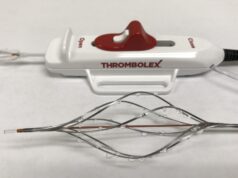Results from the OPTALYSE PE trial have been presented at the American Thoracic Society International Conference in Washington, DC, USA. The results show that pulmonary embolism (PE) can be treated effectively with EKOS (BTG) over a shorter period and at safer thrombolytic doses compared with the current treatment standard, which will allow for scheduling flexibility and efficiencies in clinician time and drug costs.
OPTALYSE PE included 101 patients with acute proximal PE at 17 centres randomised to one of four cohorts. All patients received therapeutic anticoagulation along with EKOS Acoustic Pulse Thrombolysis therapy. The first cohort received 4mg per catheter of a standard clot dissolving medication called tissue plasminogen activator (tPA) over two hours. The second cohort received 4mg per catheter tPA over four hours. The third cohort received 6mg per catheter tPA over six hours. The fourth cohort received 12mg per catheter tPA over six hours.
All cohorts saw a significant reduction in the main indicator of right heart strain from PE (measured as right ventricular to left ventricular diameter ratio) by approximately 23–26%. This is consistent with results achieved in previous EKOS studies when treatment was applied for 12–24 hours. The OPTALYSE PE results also showed a low bleeding rate of 3% compared to 10% in the previous SEATTLE II study where patients were treated with 24mg for 12 or 24 hours.
“OPTALYSE PE sets a new standard for PE treatment,” said study author. Victor Tapson (Cedars-Sinai Medical Center, Los Angeles, USA). “This trial builds on a growing body of clinical evidence, including the ULTIMA and SEATTLE II studies, showing a significant reduction in right-heart strain with shorter treatment durations and lower tPA doses. In addition to moving patients out of danger more quickly, hospitals can potentially save significant intensive care, drug and clinician time and cost due to increased safety and shorter treatment durations.”









